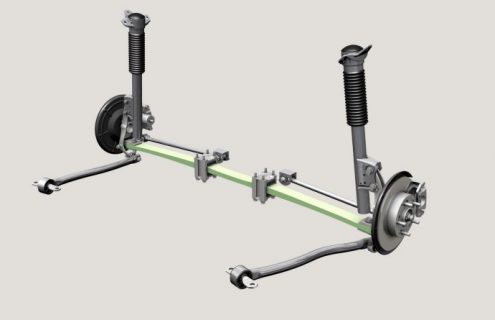Pushrods
After the Twin Overhead Cam article, I just had to bring up pushrods. Derided by many, the humble pushrod has been around as long as the overhead cam valve actuation. They are still in use, primarily in American made V8s. And they had a bit of reprieve with the advent of cylinder deactivation schemes that took advantage of specially designed hydraulic lifters – the bits between the cam lobes and the pushrods – that kept the valves from actuating on specific cylinders, in some cases an entire bank (side) of a V8 or in other cases every other cylinder in the firing order.
One of the earliest cylinder deactivation schemes was the ill-fated, un-lamented, Cadillac V8-6-4. An engine ahead of its time unfortunately. Now Chrysler is using cylinder deactivation in their V8 and to pull it off as seamlessly as possible they’re utilizing special exhaust valving to maintain the sound of the V8.
Cylinder deactivation makes a lot of sense, and it can be done in overhead cam and overhead valve engines. The idea is to reduce emissions and increase fuel economy in light load situations, where less power is required.
But the advent of variable valve timing (VANOS in BMW speak), variable valve lift (Valvetronic in BMW speak), and gasoline direct fuel injection – coupled to turbo-charging, has given even better gains than the cylinder deactivation schemes on pushrod V8s. You can start with less displacement to begin with. And we’ve seen that with the 3.0L N54/N54 making V8 power and returning small 6 cylinder fuel economy.
The age of pushrod engines is pretty much behind us, but they worked, were simple to maintain, and could make prodigious amounts of power. If you think that pushrod V8s are low reving lumps, be aware that with a little work a Chevy small block can be made to turn 9,000 RPM reliably.
So, pushrods will be with us for the near future in specialty vehicles (Corvette, CTS-V) and trucks where tradition, operational reliability, and economy of maintenance are of primary importance. Otherwise their time has passed.
Drum Brakes
Early cars had lousy brakes, operating on the drive shaft in some cases, some on one axle only, and mechanically actuated (cables, which were in need of constant and careful adjustment). Drive a Model T to see just how bad brakes can be.
In time the odd schemes for braking were standardized onto drum brakes. And in the 1930s the braking systems moved from mechanical to hydraulic actuation. It wasn’t until the 1950s that disc brakes came to the forefront in automotive braking.
The caliper type disc brakes used on the Jaguar C-Type race car were an eye-opener. Here were brakes that were able to shed heat more quickly than the big ‘Alfin’ drums (finned aluminum drum housings with a cast in steel braking surface for the brake shoes) used on race cars, and subsequently were less prone to brake fade.
So now discs have replaced drums at the front of almost all cars (and most light duty trucks). Drums are still used on the rear of many economy cars, where lighter braking loads don’t require the capabilities of a disc. However, nothing looks as silly as an 18 inch five spoke wheel with a tiny brake drum peeking out from the edges of the wheel. Four wheel discs are on almost any car that claims to be mid-ranged or above.
But here’s a dirty little secret, drum brakes are still in use – and even on BMWs! They actually are quite useful as emergency brakes. In a lot of cases there is a drum-in-hat parking brake that has brakes shoes inside the center section of the rear disc rotor. And, they’re mechanically actuated.
Look for this type of drum to be in use for some time, but as the parking brake handle is replaced by the electronic parking brake (a switch) the need for the separate drum-in-hat parking brake will be rendered obsolete.
Leaf Springs
Leaf springs have pretty much disappeared from automobiles. It wasn’t long ago that almost every American car used a live rear axle and was located (and sprung) by multi-leaf springs. They worked, but had a tougher time providing ride comfort and suffered from ‘axle tramp’ when placed under accelerative stress from a potent engine.
But I really want to bring up transverse leaf springs. The Model T used transverse leaf springs front and rear, and it allowed the Model T to negotiate the less than ideal roads (ruts is a more apt description) found in rural America at the time.
Today the Chevy Corvette is one of the few examples of an automobile with transverse leaf springs in use. But the composite material mono-leaf spring in the Corvette provides some interesting benefits. The spring can be used as a hub pickup point – it can locate the bottom of the suspension for a given wheel. It also keeps the spring weight at the lowest possible point. And it can effectively reduce the diameter required for an anti roll-bar – if implemented with appropriate mounting techniques. (If you think about it, an anti-roll bar is not much more than a transverse spring).
The Corvette engineers have kept the transverse leaf spring alive and now ZF has recently shown a transverse leaf spring rear suspension for use in small, FWD cars. It makes a lot of sense in that application. It keeps spring weight low and the srpins don’t intrude on passenger/cargo space.
So the lowly leaf spring may be making a comeback.





Author: Hugo Becker
Source: http://www.bmwblog.com/2012/02/26/the-s ... ngs-oh-my/





